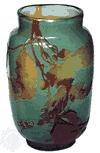- Gallé, Émile
-
died Sept. 23, 1904, NancyFrench glass and furniture designer.From 1867 he worked in his father's faience and furniture factory in Nancy. His deeply coloured opaque pieces, layered and carved or etched with plant motifs, were a great success at the Paris Exhibitions of 1878 and 1889 and were widely imitated. He used wheel cutting, acid etching, casing, and such special effects as metallic foil and air bubbles to produce what he called "marquetry of glass." His furniture designs featured floral inlay and carving; some incorporated inlaid quotations from well-known authors. A proponent of the Art Nouveau style, he collaborated with many colleagues, notably Louis Majorelle.
 Vase with relief decoration by Émile Gallé, c. 1895; in the Victoria and ...By courtesy of the Victoria and Albert Museum, London
Vase with relief decoration by Émile Gallé, c. 1895; in the Victoria and ...By courtesy of the Victoria and Albert Museum, London* * *
▪ French glass designerborn May 8, 1846, Nancy, Fr.died Sept. 23, 1904, Nancycelebrated French designer and pioneer in technical innovations in glass. He was a leading initiator of the Art Nouveau style and of the modern renaissance of French art glass.The son of a successful faience and furniture producer, Gallé studied philosophy, botany, and drawing, later learning glassmaking at Meisenthal, Fr. After the Franco-German War (1870–71), he went to work in his father's factory at Nancy. He first made clear glass, lightly tinted and decorated with enamel and engraving, but he soon developed the use of deeply coloured, almost opaque glasses in heavy masses, often layered in several thicknesses and carved or etched to form plant motifs. His glass was a great success at the Paris Exhibition of 1878, and he became known as a spirited designer working in contemporary revival styles.Gallé's strikingly original work made a great impression when it was exhibited at the Paris Exposition of 1889. Over the next decade his glass, reflecting the prevailing interest in Japanese art, became internationally known and imitated. It contributed largely to the free, asymmetric naturalism and symbolistic overtones of Art Nouveau. He employed wheel cutting, acid etching, casing (i.e., layers of various glass), and special effects such as metallic foils and air bubbles, calling his experiments marqueterie de verre (“marquetry of glass”). At Nancy he led the revival of craftsmanship and the subsequent dissemination of crafted glass by way of mass production. At the height of its productivity, during the late 19th century, his workshop employed nearly 300 associates. He attracted numerous artisans, including the Art Nouveau glassmaker Eugène Rousseau. After Gallé's death his glass enterprise continued production until 1913.With Gallé as its creative force, a form of naturalism, predominantly floristic, developed that was later identified with The School at Nancy, Provincial Alliance of Art Industries, established in 1901. His study of botany was the source for his natural designs, which represented leaves, ethereal flowers, vines, and fruits. His furniture designs, based on the Rococo period, continued the French tradition of emphasizing constructive points organically (e.g., corners of armoires finished in the shape of stalks or tree branches) and employing inlay and carving that were essentially floral in style. Perhaps his most characteristic concept was his meubles parlants (“talking furniture”), which incorporated in its decoration inlaid quotations from leading contemporary Symbolist authors such as Maurice Maeterlinck and Paul Verlaine. Both his glass and furniture were signed, sometimes most imaginatively. He collaborated with many colleagues, most notably the Art Nouveau furniture designer Louis Majorelle.L. de Fourcaud's Émile Gallé (1903) preceded Gallé's own book Écrits pour l'art 1884–89 (“Writings on Art 1884–89”), which was posthumously published in 1908.* * *
Universalium. 2010.
